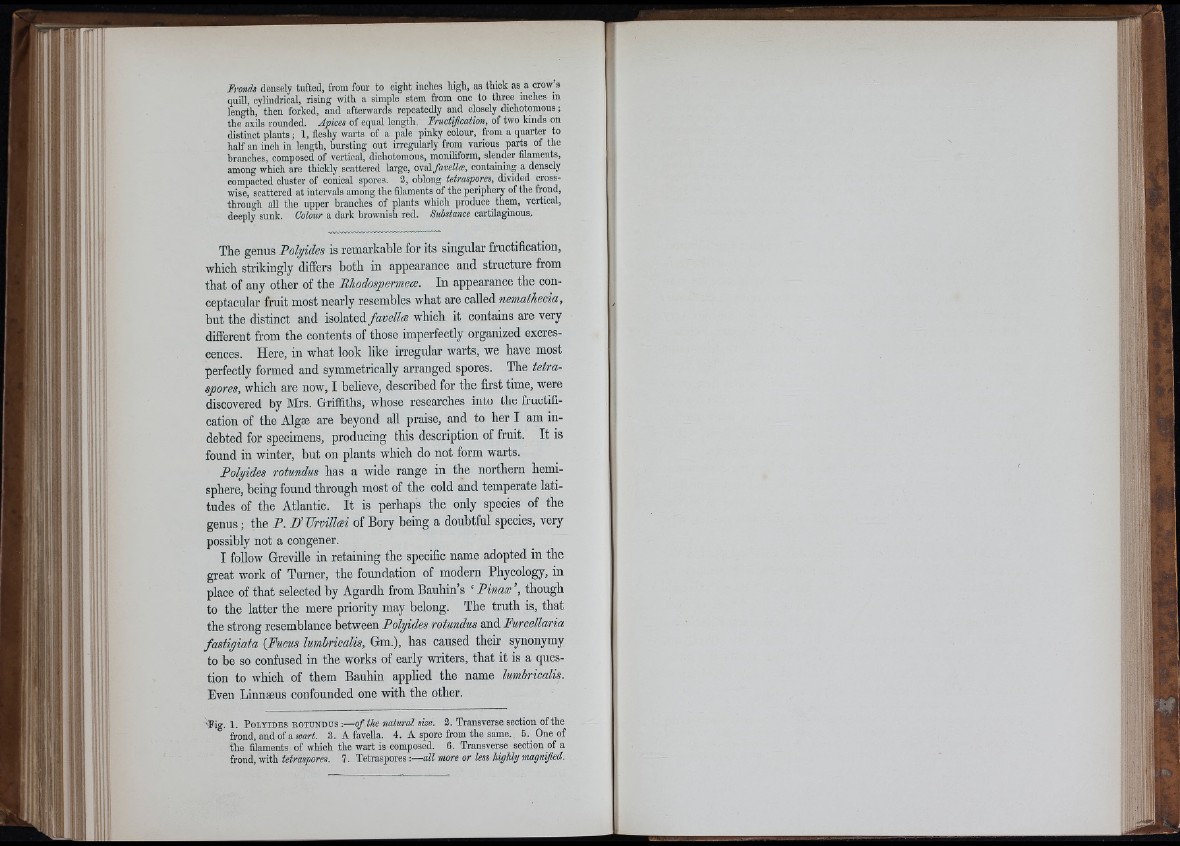
■,'il
Eronds densely tufted, from four to eight inches high, as thick as a crow’s
quill, cylindrical, rising with a simple stem from one to three inches in
length, then forked, and afterwards repeatedly and closely dichotomous ;
the axils rounded. Apices of equal length. Eructification, of two kinds on
distinct plants ; 1 , fleshy warts of a pale pinky colour, from a quarter to
half an inch in length, bursting out irregularly from various parts of the
branches, composed of vertical, diohotomous, moniliform, slender filaments,
among which are thickly scattered large, oval/«re//«, containing a densely
compacted cluster of conical spores. 3, oblong tetraspores, divided crosswise,
scattered at intervals among the filaments of the periphery of the frond,
through all the upper branches of plants which produce them, vertical,
deeply sunk. Colour a dark brownish red. Suhstance cartilaginous.
The genus Polyides is remarkable for its singular fructification,
which strikingly differs both in appearance and structure from
that of any other of the Phodospermeæ. In appearance the conceptacular
fruit most nearly resembles what are called nemathecia,
but the distinct and isolated favellæ which it contains are very
different from the contents of those imperfectly organized excrescences.
Here, in what look like irregular warts, we have most
perfectly formed and symmetrically arranged spores. The tetraspores,
which are now, I believe, described for the first time, were
discovered by Mrs. Griffitbs, whose researches into the fructification
of the Algæ are beyond all praise, and to her I am indebted
for specimens, producing this description of fruit. It is
found in winter, but on plants which do not form warts.
Polyides rotundus has a wide range in the northern hemisphere,
being found through most of the cold and temperate latitudes
of the Atlantic. It is perhaps the only species of the
genus ; the P. D’TJroilloei of Bory being a doubtful species, very
possibly not a congener.
I follow Greville in retaining the specific name adopted in the
great work of Turner, the foundation of modern Phycology, in
place of that selected by Agardh from Bauhin’s ‘ Pinaæ ’, though
to the latter the mere priority may belong. The truth is, that
the strong resemblance between Polyides rotundus and Fmcellaria
fastigiata {Fucus lumbricalis, Gm.), has caused their synonymy
to be so confused in the works of early writers, that it is a question
to which of them Bauhin applied the name lumbricalis.
Even Linnæus confounded one with the other.
'Fig. 1. P o l y id e s bottindus ;—o f the natural size. 3. Transverse section of the
frond, and ofaioart. 3. A faveUa. 4. A spore from the same. 5.^ One of
the filaments of which the wart is composed. 6. Transverse section of a
frond, with/eirasjoom. 7. Tetraspores:—all more or less i